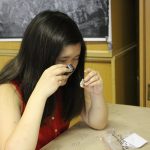Blog posted by Audrey Choi
Feeling the Heat: Investigating Fracture Patterns on Cremated Human Remains
My job for the season is to learn more about Bronze Age funerary practices by fearlessly delving into the blaze of the funeral pyre. How do I successfully accomplish this task without catching fire and meeting a similar fate as my subject, you ask? No time machines or superpowers are necessary—I instead read the clues provided to me by the fracture patterns that form on the surface of human bone during cremation.
As a member of the BAKOTA Project’s “Bone Team,” I investigate cremated human remains with the goal of answering broader questions addressing the connections between the living and dead. Mortuary archaeology is extremely significant because identities in death typically mimic those in life. Therefore, we are hoping that the cemetery site of Békés 103 will tell us how the local population fit into the dynamic social and economic world of Bronze Age Central Europe. The ways in which the dead were treated provide us with valuable insight into these individuals’ belief systems and, fortunately for us, sometimes leave their marks upon bone for our analyses thousands of years later.
What can heat-induced fracture patterns reveal to us about the people laid to rest in Békés 103? Fracture patterns can help us understand the characteristics of the funeral fire as well as the various reactions bone can assume under stress. The manifestation of fracture types depends heavily upon several variables, including the status of the body prior to cremation, the anatomical location, the spatial and temporal context, the unique dynamics of the fire, and the biological condition of the bone itself. The frequency of diagnostic fractures within and across human burials can therefore be indicative of key biological and cultural trends.
Before beginning to tease out these trends, however, we must first determine what fractures can be found on the bone fragments of Békés 103. Past research has focused on fracture patterns within a single burial, but this summer I am examining fracture patterns across multiple burials. I am focusing solely on fragments that can be identified as belonging to a specific bone or anatomical region. After assigning my fragment a number, I mark whether or not certain fracture types that are associated with the corresponding anatomical location are absent or present; for ambiguous cases, I do not give the fragment a score. Because each fragment is categorized according its urn layer and each human burial is categorized according to its area in the cemetery, I ensure that details regarding every fragment’s original setting are diligently documented.
As I mentioned before, an understanding of the distribution of fracture patterns has the potential to unlock a treasure trove of knowledge about the inhabitants occupying Békés 103. This understanding is especially compelling when combined with data from the projects of my colleagues. I am unbelievably excited to evaluate our complete dataset and possibly unearth information that will guide the course of future research at Békés 103.
For a great overview on human cremains: http://science.howstuffworks.com/cremation1.htm
All about bone biology: https://www.iofbonehealth.org/introduction-bone-biology-all-about-our-bones


